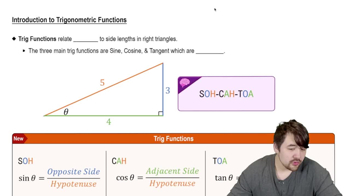Table of contents
- 0. Functions7h 52m
- Introduction to Functions16m
- Piecewise Functions10m
- Properties of Functions9m
- Common Functions1h 8m
- Transformations5m
- Combining Functions27m
- Exponent rules32m
- Exponential Functions28m
- Logarithmic Functions24m
- Properties of Logarithms34m
- Exponential & Logarithmic Equations35m
- Introduction to Trigonometric Functions38m
- Graphs of Trigonometric Functions44m
- Trigonometric Identities47m
- Inverse Trigonometric Functions48m
- 1. Limits and Continuity2h 2m
- 2. Intro to Derivatives1h 33m
- 3. Techniques of Differentiation3h 18m
- 4. Applications of Derivatives2h 38m
- 5. Graphical Applications of Derivatives6h 2m
- 6. Derivatives of Inverse, Exponential, & Logarithmic Functions2h 37m
- 7. Antiderivatives & Indefinite Integrals1h 26m
- 8. Definite Integrals4h 44m
- 9. Graphical Applications of Integrals2h 27m
- 10. Physics Applications of Integrals 2h 22m
1. Limits and Continuity
Finding Limits Algebraically
Problem 3.5.17
Textbook Question
Use Theorem 3.10 to evaluate the following limits.
lim x🠂0 (tan 7x) / (sin x)
 Verified step by step guidance
Verified step by step guidance1
Theorem 3.10 refers to the limit of a function as it approaches a point, often involving L'Hôpital's Rule when dealing with indeterminate forms like 0/0. First, check if the limit results in an indeterminate form by substituting x = 0 into the expression (tan 7x) / (sin x).
Substitute x = 0 into tan(7x) and sin(x). Both tan(7x) and sin(x) approach 0 as x approaches 0, resulting in the indeterminate form 0/0. This indicates that L'Hôpital's Rule can be applied.
Apply L'Hôpital's Rule, which states that if the limit of f(x)/g(x) as x approaches a value results in 0/0 or ∞/∞, then the limit can be found by differentiating the numerator and the denominator separately. Differentiate the numerator tan(7x) and the denominator sin(x) with respect to x.
The derivative of tan(7x) with respect to x is 7sec²(7x), and the derivative of sin(x) with respect to x is cos(x). Substitute these derivatives back into the limit expression, resulting in lim x→0 (7sec²(7x)) / (cos(x)).
Evaluate the new limit expression as x approaches 0. Substitute x = 0 into the expression 7sec²(7x) / cos(x). Since sec(7x) = 1/cos(7x), and cos(0) = 1, the expression simplifies to 7 * (1/1)² / 1, which can be further simplified to find the limit.
 Verified video answer for a similar problem:
Verified video answer for a similar problem:This video solution was recommended by our tutors as helpful for the problem above
Video duration:
6mPlay a video:
Was this helpful?
Key Concepts
Here are the essential concepts you must grasp in order to answer the question correctly.
Limits
Limits are fundamental in calculus, representing the value that a function approaches as the input approaches a certain point. Understanding limits is crucial for evaluating expressions that may be indeterminate, such as 0/0. In this context, we need to analyze the behavior of the function as x approaches 0.
Recommended video:

One-Sided Limits
Theorem 3.10 (L'Hôpital's Rule)
Theorem 3.10, commonly known as L'Hôpital's Rule, provides a method for evaluating limits of indeterminate forms like 0/0 or ∞/∞. It states that if the limit of f(x)/g(x) results in an indeterminate form, the limit can be found by taking the derivative of the numerator and the derivative of the denominator separately, then re-evaluating the limit.
Recommended video:

Fundamental Theorem of Calculus Part 1
Trigonometric Limits
Trigonometric limits involve the behavior of trigonometric functions as their arguments approach specific values. For example, limits involving sin(x) and tan(x) as x approaches 0 are particularly important, as they often simplify to well-known values, such as sin(x)/x approaching 1. Recognizing these standard limits can greatly aid in solving more complex limit problems.
Recommended video:

Introduction to Trigonometric Functions

 5:21m
5:21mWatch next
Master Finding Limits by Direct Substitution with a bite sized video explanation from Callie
Start learningRelated Videos
Related Practice







